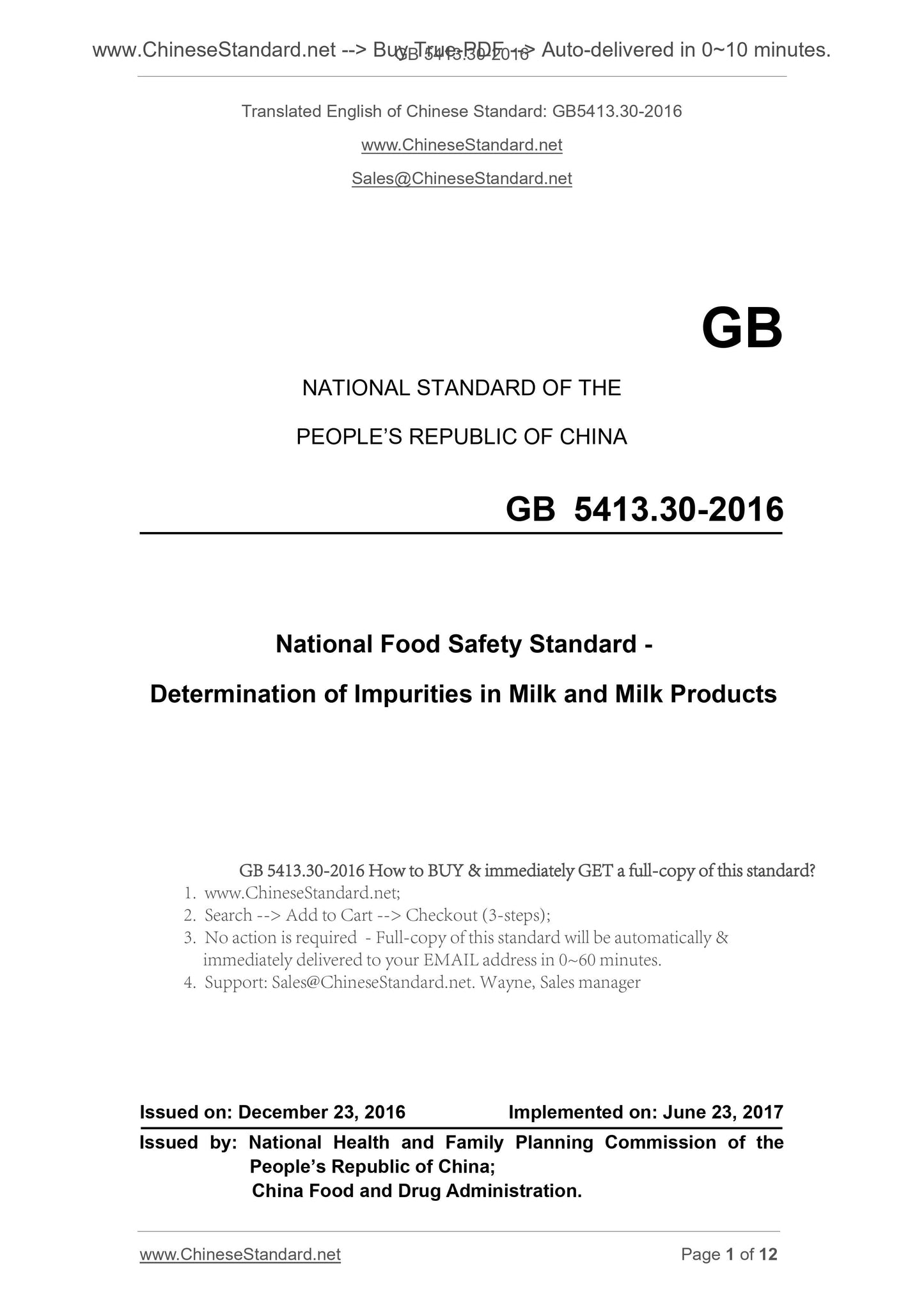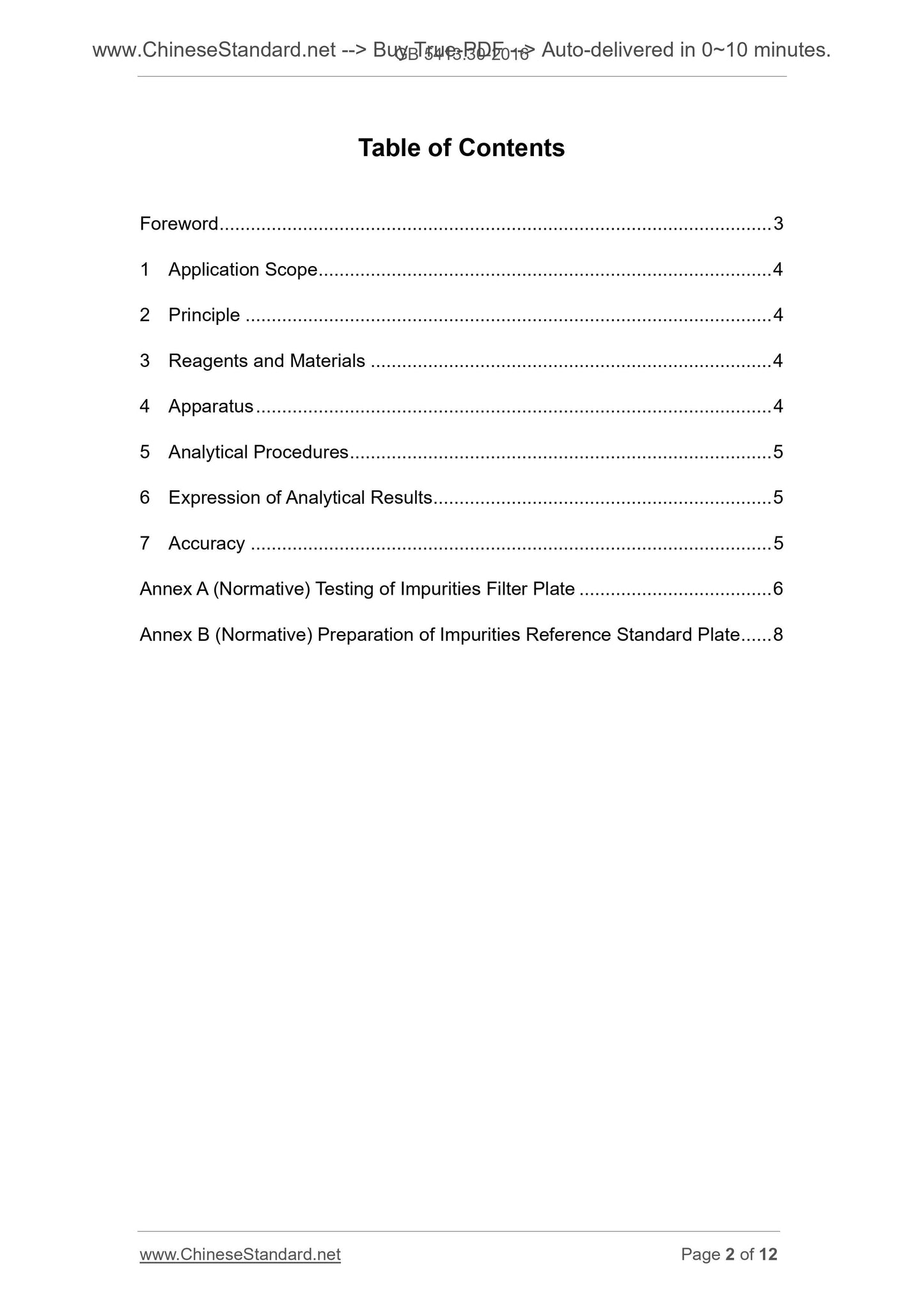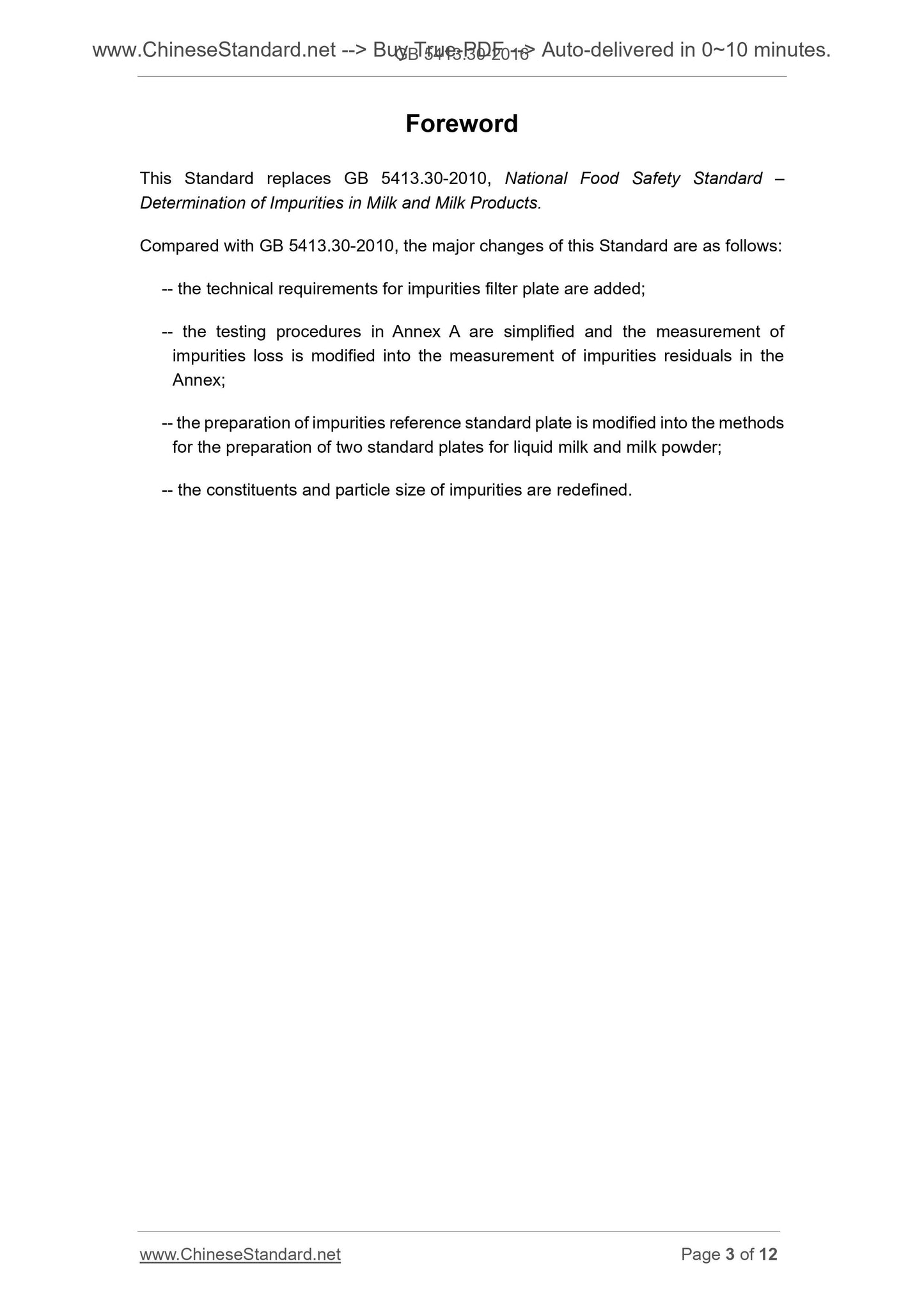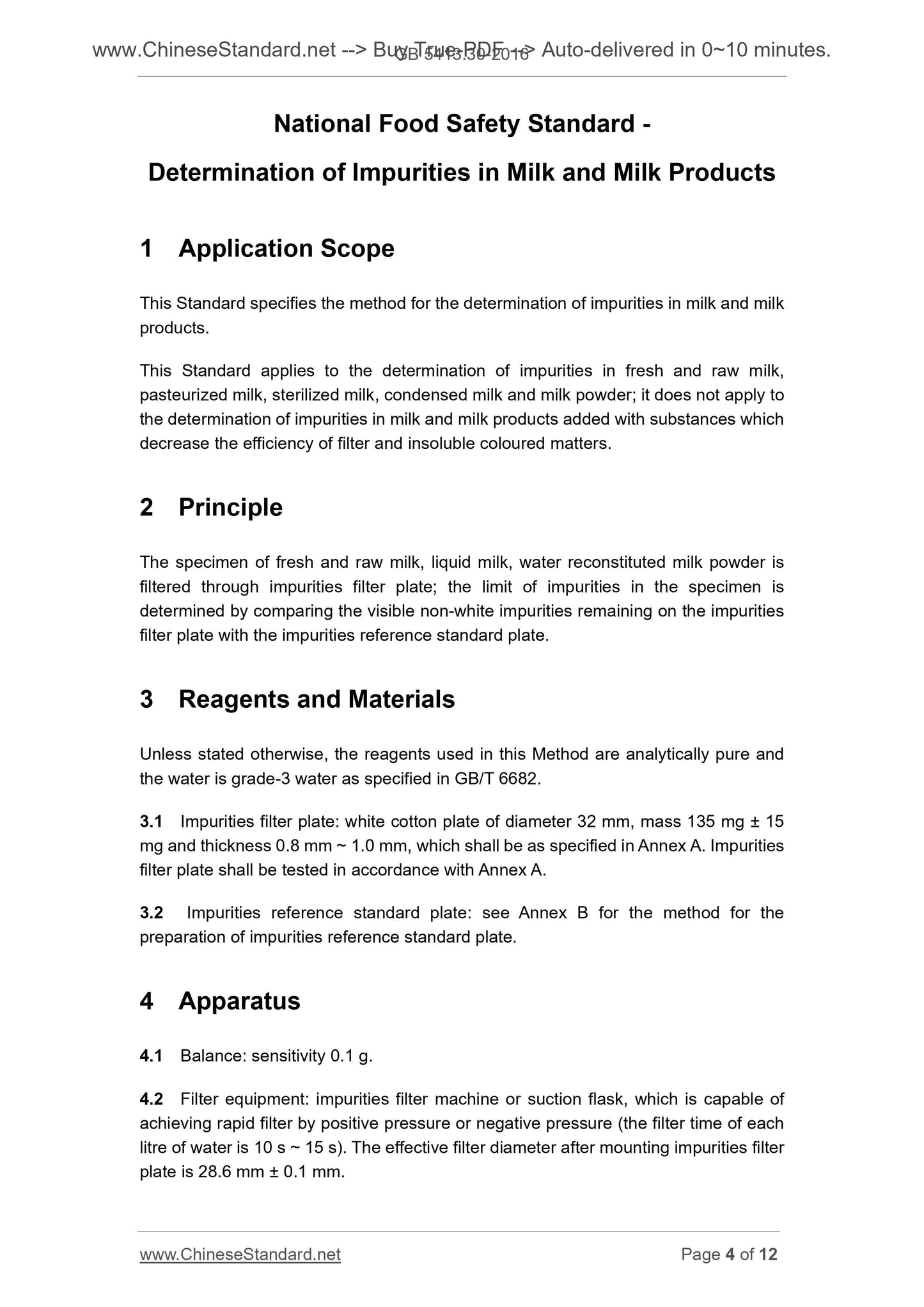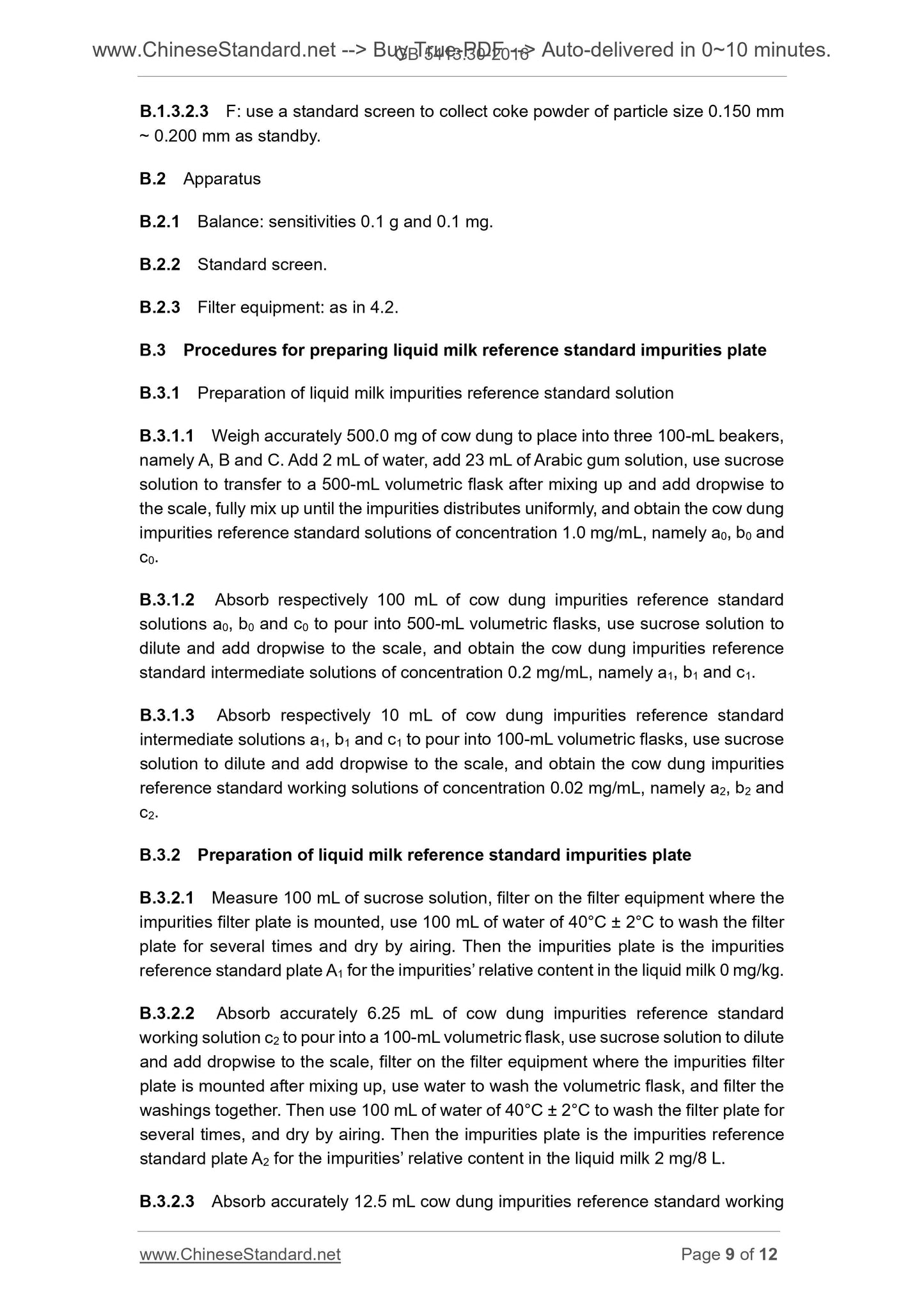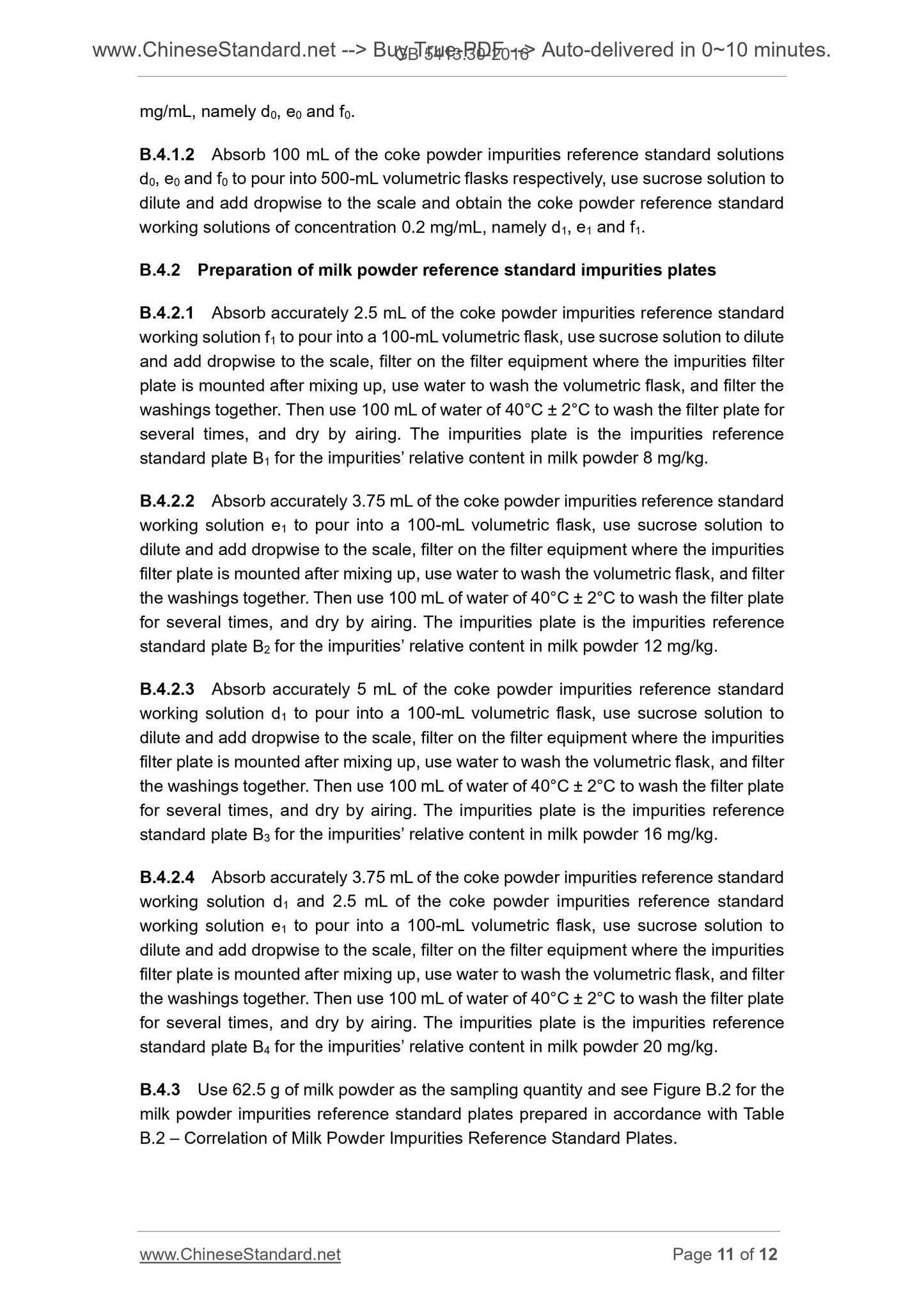1
/
of
6
PayPal, credit cards. Download editable-PDF & invoice in 1 second!
GB 5413.30-2016 English PDF (GB5413.30-2016)
GB 5413.30-2016 English PDF (GB5413.30-2016)
Regular price
$70.00 USD
Regular price
Sale price
$70.00 USD
Unit price
/
per
Shipping calculated at checkout.
Couldn't load pickup availability
Delivery: 3 seconds. Download true-PDF + Invoice.
Get QUOTATION in 1-minute: Click GB 5413.30-2016
Historical versions: GB 5413.30-2016
Preview True-PDF (Reload/Scroll if blank)
GB 5413.30-2016: National Food Safety Standard -- Determination of Impurities in Milk and Milk Products
GB 5413.30-2016
GB
NATIONAL STANDARD OF THE
PEOPLE’S REPUBLIC OF CHINA
National Food Safety Standard -
Determination of Impurities in Milk and Milk Products
ISSUED ON. DECEMBER 23, 2016
IMPLEMENTED ON. JUNE 23, 2017
Issued by. National Health and Family Planning Commission of the
People’s Republic of China;
China Food and Drug Administration.
3. No action is required - Full-copy of this standard will be automatically and
immediately delivered to your EMAIL address in 0~60 minutes.
Table of Contents
Foreword ... 3
1 Application Scope ... 4
2 Principle ... 4
3 Reagents and Materials ... 4
4 Apparatus ... 4
5 Analytical Procedures ... 5
6 Expression of Analytical Results ... 5
7 Accuracy ... 5
Annex A (Normative) Testing of Impurities Filter Plate ... 6
Annex B (Normative) Preparation of Impurities Reference Standard Plate ... 8
Foreword
This Standard replaces GB 5413.30-2010, National Food Safety Standard –
Determination of Impurities in Milk and Milk Products.
Compared with GB 5413.30-2010, the major changes of this Standard are as follows.
-- the technical requirements for impurities filter plate are added;
-- the testing procedures in Annex A are simplified and the measurement of
impurities loss is modified into the measurement of impurities residuals in the
Annex;
-- the preparation of impurities reference standard plate is modified into the methods
for the preparation of two standard plates for liquid milk and milk powder;
-- the constituents and particle size of impurities are redefined.
National Food Safety Standard -
Determination of Impurities in Milk and Milk Products
1 Application Scope
This Standard specifies the method for the determination of impurities in milk and milk
products.
This Standard applies to the determination of impurities in fresh and raw milk,
pasteurized milk, sterilized milk, condensed milk and milk powder; it does not apply to
the determination of impurities in milk and milk products added with substances which
decrease the efficiency of filter and insoluble coloured matters.
2 Principle
The specimen of fresh and raw milk, liquid milk, water reconstituted milk powder is
filtered through impurities filter plate; the limit of impurities in the specimen is
determined by comparing the visible non-white impurities remaining on the impurities
filter plate with the impurities reference standard plate.
3 Reagents and Materials
Unless stated otherwise, the reagents used in this Method are analytically pure and
the water is grade-3 water as specified in GB/T 6682.
3.1 Impurities filter plate. white cotton plate of diameter 32 mm, mass 135 mg ± 15
mg and thickness 0.8 mm ~ 1.0 mm, which shall be as specified in Annex A. Impurities
filter plate shall be tested in accordance with Annex A.
3.2 Impurities reference standard plate. see Annex B for the method for the
preparation of impurities reference standard plate.
4 Apparatus
4.1 Balance. sensitivity 0.1 g.
4.2 Filter equipment. impurities filter machine or suction flask, which is capable of
achieving rapid filter by positive pressure or negative pressure (the filter time of each
litre of water is 10 s ~ 15 s). The effective filter diameter after mounting impurities filter
plate is 28.6 mm ± 0.1 mm.
B.1.3.2.3 F. use a standard screen to collect coke powder of particle size 0.150 mm
~ 0.200 mm as standby.
B.2 Apparatus
B.2.1 Balance. sensitivities 0.1 g and 0.1 mg.
B.2.2 Standard screen.
B.2.3 Filter equipment. as in 4.2.
B.3 Procedures for preparing liquid milk reference standard impurities plate
B.3.1 Preparation of liquid milk impurities reference standard solution
B.3.1.1 Weigh accurately 500.0 mg of cow dung to place into three 100-mL beakers,
namely A, B and C. Add 2 mL of water, add 23 mL of Arabic gum solution, use sucrose
solution to transfer to a 500-mL volumetric flask after mixing up and add dropwise to
the scale, fully mix up until the impurities distributes uniformly, and obtain the cow dung
impurities reference standard solutions of concentration 1.0 mg/mL, namely a0, b0 and
c0.
B.3.1.2 Absorb respectively 100 mL of cow dung impurities reference standard
solutions a0, b0 and c0 to pour into 500-mL volumetric flasks, use sucrose solution to
dilute and add dropwise to the scale, and obtain the cow dung impurities reference
standard intermediate solutions of concentration 0.2 mg/mL, namely a1, b1 and c1.
B.3.1.3 Absorb respectively 10 mL of cow dung impurities reference standard
intermediate solutions a1, b1 and c1 to pour into 100-mL volumetric flasks, use sucrose
solution to dilute and add dropwise to the scale, and obtain the cow dung impurities
reference standard working solutions of concentration 0.02 mg/mL, namely a2, b2 and
c2.
B.3.2 Preparation of liquid milk reference standard impurities plate
B.3.2.1 Measure 100 mL of sucrose solution, filter on the filter equipment where the
impurities filter plate is mounted, use 100 mL of water of 40°C ± 2°C to wash the filter
plate for several times and dry by airing. Then the impurities plate is the impurities
reference standard plate A1 for the impurities’ relative content in the liquid milk 0 mg/kg.
B.3.2.2 Absorb accurately 6.25 mL of cow dung impurities reference standard
working solution c2 to pour into a 100-mL volumetric flask, use sucrose solution to dilute
and add dropwise to the scale, filter on the filter equipment where the impurities filter
plate is mounted after mixing up, use water to wash the volumetric flask, and filter the
washings together. Then use 100 mL of water of 40°C ± 2°C to wash the filter plate for
several times, and dry by airing. Then the impurities plate is the impurities reference
standard plate A2 for the impurities’ relative content in the liquid milk 2 mg/8 L.
B.3.2.3 Absorb accurately 12.5 mL cow dung impurities reference standard working
mg/mL, namely d0, e0 and f0.
B.4.1.2 Absorb 100 mL of the coke powder impurities reference standard solutions
d0, e0 and f0 to pour into 500-mL volumetric flasks respectively, use sucrose solution to
dilute and add dropwise to the scale and obtain the coke powder reference standard
working solutions of concentration 0.2 mg/mL, namely d1, e1 and f1.
B.4.2 Preparation of milk powder reference standard impurities plates
B.4.2.1 Absorb accurately 2.5 mL of the coke powder impurities reference standard
working solution f1 to pour into a 100-mL volumetric flask, use sucrose solution to dilute
and add dropwise to the scale, filter on the filter equipment where the impurities filter
plate is mounted after mixing up, use water to wash the volumetric flask, and filter the
washings together. Then use 100 mL of water of 40°C ± 2°C to wash the filter plate for
several times, and dry by airing. The impurities plate is the impurities reference
standard plate B1 for the impurities’ relative content in milk powder 8 mg/kg.
B.4.2.2 Absorb accurately 3.75 mL of the coke powder impurities reference standard
working solution e1 to pour into a 100-mL volumetric flask, use sucrose solution to
dilute and add dropwise to the scale, filter on the filter equipment where the impurities
filter plate is mounted after mixing up, use water to wash the volumetric flask, and filter
the washings together. Then use 100 mL of water of 40°C ± 2°C to wash the filter plate
for several times, and dry by airing. The impurities plate is the impurities reference
standard plate B2 for the impurities’ relative c...
Get QUOTATION in 1-minute: Click GB 5413.30-2016
Historical versions: GB 5413.30-2016
Preview True-PDF (Reload/Scroll if blank)
GB 5413.30-2016: National Food Safety Standard -- Determination of Impurities in Milk and Milk Products
GB 5413.30-2016
GB
NATIONAL STANDARD OF THE
PEOPLE’S REPUBLIC OF CHINA
National Food Safety Standard -
Determination of Impurities in Milk and Milk Products
ISSUED ON. DECEMBER 23, 2016
IMPLEMENTED ON. JUNE 23, 2017
Issued by. National Health and Family Planning Commission of the
People’s Republic of China;
China Food and Drug Administration.
3. No action is required - Full-copy of this standard will be automatically and
immediately delivered to your EMAIL address in 0~60 minutes.
Table of Contents
Foreword ... 3
1 Application Scope ... 4
2 Principle ... 4
3 Reagents and Materials ... 4
4 Apparatus ... 4
5 Analytical Procedures ... 5
6 Expression of Analytical Results ... 5
7 Accuracy ... 5
Annex A (Normative) Testing of Impurities Filter Plate ... 6
Annex B (Normative) Preparation of Impurities Reference Standard Plate ... 8
Foreword
This Standard replaces GB 5413.30-2010, National Food Safety Standard –
Determination of Impurities in Milk and Milk Products.
Compared with GB 5413.30-2010, the major changes of this Standard are as follows.
-- the technical requirements for impurities filter plate are added;
-- the testing procedures in Annex A are simplified and the measurement of
impurities loss is modified into the measurement of impurities residuals in the
Annex;
-- the preparation of impurities reference standard plate is modified into the methods
for the preparation of two standard plates for liquid milk and milk powder;
-- the constituents and particle size of impurities are redefined.
National Food Safety Standard -
Determination of Impurities in Milk and Milk Products
1 Application Scope
This Standard specifies the method for the determination of impurities in milk and milk
products.
This Standard applies to the determination of impurities in fresh and raw milk,
pasteurized milk, sterilized milk, condensed milk and milk powder; it does not apply to
the determination of impurities in milk and milk products added with substances which
decrease the efficiency of filter and insoluble coloured matters.
2 Principle
The specimen of fresh and raw milk, liquid milk, water reconstituted milk powder is
filtered through impurities filter plate; the limit of impurities in the specimen is
determined by comparing the visible non-white impurities remaining on the impurities
filter plate with the impurities reference standard plate.
3 Reagents and Materials
Unless stated otherwise, the reagents used in this Method are analytically pure and
the water is grade-3 water as specified in GB/T 6682.
3.1 Impurities filter plate. white cotton plate of diameter 32 mm, mass 135 mg ± 15
mg and thickness 0.8 mm ~ 1.0 mm, which shall be as specified in Annex A. Impurities
filter plate shall be tested in accordance with Annex A.
3.2 Impurities reference standard plate. see Annex B for the method for the
preparation of impurities reference standard plate.
4 Apparatus
4.1 Balance. sensitivity 0.1 g.
4.2 Filter equipment. impurities filter machine or suction flask, which is capable of
achieving rapid filter by positive pressure or negative pressure (the filter time of each
litre of water is 10 s ~ 15 s). The effective filter diameter after mounting impurities filter
plate is 28.6 mm ± 0.1 mm.
B.1.3.2.3 F. use a standard screen to collect coke powder of particle size 0.150 mm
~ 0.200 mm as standby.
B.2 Apparatus
B.2.1 Balance. sensitivities 0.1 g and 0.1 mg.
B.2.2 Standard screen.
B.2.3 Filter equipment. as in 4.2.
B.3 Procedures for preparing liquid milk reference standard impurities plate
B.3.1 Preparation of liquid milk impurities reference standard solution
B.3.1.1 Weigh accurately 500.0 mg of cow dung to place into three 100-mL beakers,
namely A, B and C. Add 2 mL of water, add 23 mL of Arabic gum solution, use sucrose
solution to transfer to a 500-mL volumetric flask after mixing up and add dropwise to
the scale, fully mix up until the impurities distributes uniformly, and obtain the cow dung
impurities reference standard solutions of concentration 1.0 mg/mL, namely a0, b0 and
c0.
B.3.1.2 Absorb respectively 100 mL of cow dung impurities reference standard
solutions a0, b0 and c0 to pour into 500-mL volumetric flasks, use sucrose solution to
dilute and add dropwise to the scale, and obtain the cow dung impurities reference
standard intermediate solutions of concentration 0.2 mg/mL, namely a1, b1 and c1.
B.3.1.3 Absorb respectively 10 mL of cow dung impurities reference standard
intermediate solutions a1, b1 and c1 to pour into 100-mL volumetric flasks, use sucrose
solution to dilute and add dropwise to the scale, and obtain the cow dung impurities
reference standard working solutions of concentration 0.02 mg/mL, namely a2, b2 and
c2.
B.3.2 Preparation of liquid milk reference standard impurities plate
B.3.2.1 Measure 100 mL of sucrose solution, filter on the filter equipment where the
impurities filter plate is mounted, use 100 mL of water of 40°C ± 2°C to wash the filter
plate for several times and dry by airing. Then the impurities plate is the impurities
reference standard plate A1 for the impurities’ relative content in the liquid milk 0 mg/kg.
B.3.2.2 Absorb accurately 6.25 mL of cow dung impurities reference standard
working solution c2 to pour into a 100-mL volumetric flask, use sucrose solution to dilute
and add dropwise to the scale, filter on the filter equipment where the impurities filter
plate is mounted after mixing up, use water to wash the volumetric flask, and filter the
washings together. Then use 100 mL of water of 40°C ± 2°C to wash the filter plate for
several times, and dry by airing. Then the impurities plate is the impurities reference
standard plate A2 for the impurities’ relative content in the liquid milk 2 mg/8 L.
B.3.2.3 Absorb accurately 12.5 mL cow dung impurities reference standard working
mg/mL, namely d0, e0 and f0.
B.4.1.2 Absorb 100 mL of the coke powder impurities reference standard solutions
d0, e0 and f0 to pour into 500-mL volumetric flasks respectively, use sucrose solution to
dilute and add dropwise to the scale and obtain the coke powder reference standard
working solutions of concentration 0.2 mg/mL, namely d1, e1 and f1.
B.4.2 Preparation of milk powder reference standard impurities plates
B.4.2.1 Absorb accurately 2.5 mL of the coke powder impurities reference standard
working solution f1 to pour into a 100-mL volumetric flask, use sucrose solution to dilute
and add dropwise to the scale, filter on the filter equipment where the impurities filter
plate is mounted after mixing up, use water to wash the volumetric flask, and filter the
washings together. Then use 100 mL of water of 40°C ± 2°C to wash the filter plate for
several times, and dry by airing. The impurities plate is the impurities reference
standard plate B1 for the impurities’ relative content in milk powder 8 mg/kg.
B.4.2.2 Absorb accurately 3.75 mL of the coke powder impurities reference standard
working solution e1 to pour into a 100-mL volumetric flask, use sucrose solution to
dilute and add dropwise to the scale, filter on the filter equipment where the impurities
filter plate is mounted after mixing up, use water to wash the volumetric flask, and filter
the washings together. Then use 100 mL of water of 40°C ± 2°C to wash the filter plate
for several times, and dry by airing. The impurities plate is the impurities reference
standard plate B2 for the impurities’ relative c...
Share
